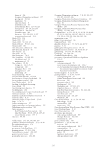Lake Eyre Basin Rivers 132 because its members had developed large parts of the floodplain for their private storages and crops, the rivers could no longer flow onto these parts. The irrigation community argued and then calculated what volumes of water were forgone, if there was a natural floodplain. They successfully convinced a compliant Queensland Government that this volume then needed to be added to their water harvesting licences. If any semblance of equity existed, the same argument should have been applied to the downstream floodplains on graziers’ stations, whose water was taken by the irrigation developments upstream. The overland flow concept excluded all other rights to water on the floodplain. Once again, the lobbying power was effective a ‘loop hole’ was identified. The Queensland water agency allowed further take from the river to a voracious irrigation industry. It did not help that more than half of the wetlands in the Condamine–Balonne catchment were in New South Wales (Kingsford et al. 2004), a considerably smaller proportion of the catchment, with most of water coming from Queensland. In 2004, the Lower Balonne Water Resource Plan was passed into law (Queensland Government 2004), the first year that the full impacts of development affected a flood. The Murray–Darling Basin Plan was introduced in 2012 (Murray–Darling Basin Authority 2012), with a commitment to review the state of the science in the Darling Basin (Murray–Darling Basin Authority 2016c). Under the Basin Plan, there was a commitment to return 390 GL/year, from current diversions in the Darling River catchments, including the Condamine–Balonne, to the river environment. In late 2016, the Murray–Darling Basin Authority proposed that this volume of environmental water be decreased to 320 GL/year, with a reduction from 142 GL/year to 100 GL/year in the Condamine–Balonne catchment (Murray–Darling Basin Authority 2016a). This reduction in environmental flow meant that the Australian Government would not buy back water from the irrigation industry and, in so doing, reduce the socio-economic impact on the Queensland town of Dirranbandi. The transparency of the science and the hydrological modelling had improved, but the modelling during periods of low flows was extremely unreliable. The impacts About 50% of the water that once went to the environment in the Condamine–Balonne is now diverted, categorised at a very high to extremely high level of development, ranked third-highest out of 18 catchments in the Murray–Darling Basin (CSIRO 2008b). Much of this water would have inundated the vast floodplain of the Lower Balonne river system of more than 1.4 million ha (Kingsford et al. 2004). By 2008, only 5% of the flow reached the Darling River and there was widespread evidence of damage to the floodplain. There was such concern within government circles about the long-term impacts that a review of the science was commissioned, chaired by well-known freshwater scientist, Professor Peter Cullen (Cullen et al. 2003). The irrigators seized on a comment in the review that the floodplain was currently in good condition, avoiding mentioning the subsequent warning that impacts take time to show up. Professor Cullen later remarked that ‘by the time they get the science right, the patient will be dead’ (Senate Standing Committee on Rural and Regional Affairs and Transport 2006). The irrigation industry cleverly used highly selective
Downloaded from CSIRO with access from at 216.73.216.128 on Nov 9, 2025, 7:57 AM. (c) CSIRO Publishing

















































































































































































































































































